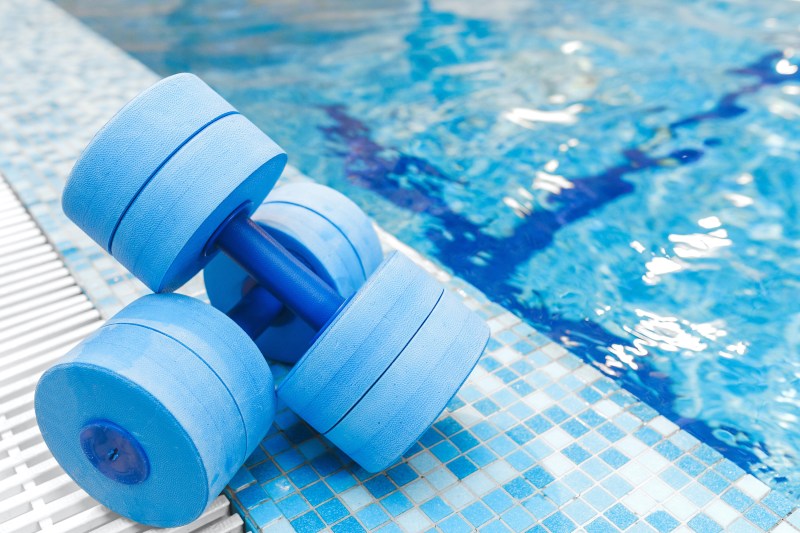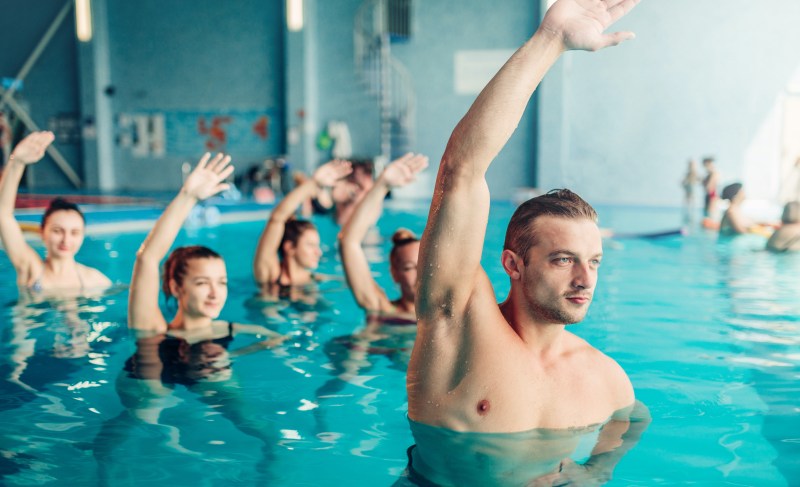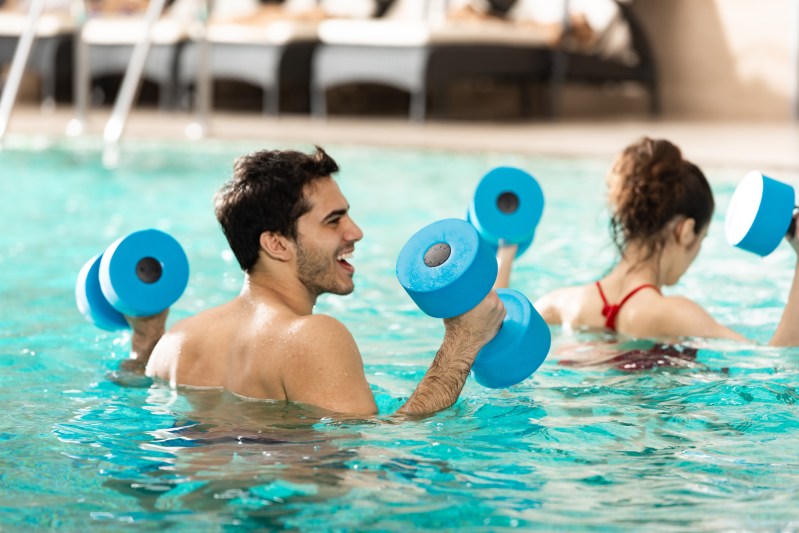
If you want an effective exercise that’s easy on your joints and muscles, consider water aerobics. This low-impact workout allows you to challenge yourself whenever you want an intense regimen because it blends both light strength training and cardio every time you do it. The intensity level is up to you.
Water aerobics help lend your routine versatility. Some days, you’ll press hard against the water resistance, while other days, you’ll take it easy. You can effortlessly switch up the potency to fit your needs, fitness level, and schedule.
This ultimate guide is for advanced practitioners and newbies alike. Find out more about water or aqua aerobics to increase your knowledge about a highly effective way to exercise, stay fit, and have fun.

What are water aerobics?
Water aerobics are defined as the performance of aerobic exercise in water, typically waist deep. This method helps increase endurance as well as your muscle strength through a low-impact workout of various intensity levels. You’ll find the routines and ranges fun, invigorating, and challenging.
A typical water aerobics class lasts between 30 and 90 minutes. Find an experienced instructor who leads you through each movement. The most popular classes involve a lot of energy and great music.
When you attend a water aerobics class, expect a few minutes of warming up in the beginning and cooling down at the end. The class itself usually involves a lot of cardio and strength-training exercises. This includes movements like bicep curls, water walking, leg lifts, and kickboard moves.
This is done in the shallow end of different swimming pools, so you don’t have to worry if swimming is not your thing. And if you suffer from joint problems or deal with chronic pain, the buoyancy of the water will feel good. This is also true for anyone recovering from injuries.
Just because water aerobics is low-impact doesn’t mean you have to take it easy. In fact, make the workouts more challenging by increasing the repetitions of each movement. You might also go faster while working out or choose a more advanced class that involves underwater interval training for more of a challenge.

What are the benefits of water aerobics?
Increases wellness
When exercising in the pool, you’re using water resistance to build muscles. This is done by cupping the water with certain movements or by kicking against the water. Muscle growth helps bones stay healthy and will also help to prevent certain illnesses and disease.
Do you have high blood pressure? Aqua aerobic workouts reduce your heart rate considerably compared to exercising on land. Exercising in water increases blood flow and improves the blood vessels’ ability to dilate.
The buoyancy in water lowers the impact of and helps soothe arthritis and back pain. You won’t feel as much stress on your muscles and joints. If you do this workout in warm water, you’ll also experience less pain and the effects of inflammation around swollen muscles and sore joints.
As with any exercise routine, the more you do this, the more your heart, lungs, and muscles work better together. This not only feels good, but it also increases your fitness level and endurance.
Aids in recovery
You not only feel lighter while submerged in water, your body actually weighs less. If you’re injured, this means any sore joints or muscles won’t be as impacted or aggravated while engaged in water aerobics.
Check with your doctor, but usually, pool exercises are an ideal way to strengthen your knees, hips, or feet after an injury. Water aerobics allows you to increase overall body flexibility by adding new resistance to your routines.
You’ll also find yourself more relaxed while participating in water exercises. It reduces stress and anxiety while soothing your emotional and psychological health. This makes it easier to sleep at night, which is also important when recovering from an injury.
Helps with weight loss
If you’re trying to lose weight, studies show that water exercise reduces body fat. It also lowers cholesterol. Consult a dietician or doctor for the amount of calories you should burn and then adjust the intensity of your workouts accordingly.
If possible, experiment with the depth and temperature of the pool that you use. If you move faster in deeper, colder water, you will lose more weight. Kicking it up a notch can also turn more fat into muscles. Lean bodies weigh a bit more, but clothes fit you better, and you’ll also enjoy better body composition.

Are there any downsides?
Lifestyle changes have some downsides, so be sure to consider your own personal circumstances when looking for an aquatic exercise routine. Weigh the advantages and disadvantages. Talk to professionals and get plenty of information to make an informed decision.
If you’re looking for a professional class, give the pool water a try before attending a class. You want to be sure you can tolerate the chemicals being used. Some exercise facilities use chlorine or bromine, which can result in the following side effects:
- Itchy skin
- Red or puffy eyes
- Respiratory irritation
If you have a mild sensitivity to public pools, you may find that showering afterward takes care of it. It’s better to know for sure, so test out the pool ahead of time.
You also won’t burn as many calories while working out in a pool. This may cause you to choose a more conventional workout outside the water. Just keep in mind your risk for injury goes up when exercising on land.
If you can’t swim, water aerobics increases your risk of drowning. Reduce this risk by taking swimming lessons or always exercising when a lifeguard is on duty. You can also stay in the shallow end to be safer.

Who benefits the most from water aerobics?
Seniors
Senior citizens benefit a great deal from water aerobics. Any kind of water-based activity provides older folks with increased metabolism and strength. It also provides a way to slow down the aging process, which results in muscle loss, impaired cardiovascular health, and delayed reaction times.
It’s also harder for seniors to lose weight. Aquatic exercise helps elderly folks lose weight by providing a low-impact way to burn fat while protecting joints from injury.
Pregnant people
Pregnancy is a great reason to get into gentle water aerobics. It feels so good to be in the water and utilize it to support the belly and relieve pressure from the pelvis and spine. Be sure to talk with your doctor ahead of time, but usually, water workouts allow you to keep your body’s muscles working while lowering your risk of exercise-related injuries and muscle strains.
Children
Kids love playing in the water. They don’t even realize water aerobics is good for them! They’re having a great time while getting important exercise, reducing pain, and improving circulation.
It also reduces risk of obesity, joint damage, and cardiac issues. Water workouts are great activities that parents and their children can do together.

Types of water aerobics classes
Beginner’s class
To get started, find a water fitness class that advertises an all-around great workout without any added pressure to keep up. It should be a safe and fun environment. Look for class descriptions that advertise to all skill levels.
Boot camp
If you want movements like lunges, jumps, kicks, and water running, try a full boot camp experience. Instructors balance intensive cardio movements while also focusing on strengthening and toning routines. They may also add noodles, weights, or kickboards.
Water dancing
Want to move and groove while being gentle with your hips and knees? Water dancing classes feel more like a party than a class. You’ll burn serious calories while learning ballet, modern, or hip-hop-adapted movements that develop strength in your core and upper body.
Aqua yoga
Aqua yoga takes revered principles and poses from traditional yoga and adapts them to a shallow water environment. You’ll enjoy deep stretches that soothe your joints and spine. It’s a gentle, lovely way to increase your flexibility.
Advanced
Look for classes that call for experienced students. You’ll bring your low-impact workout to the next level. Some combine themes, like mixing ballet and yoga in the pool. This allows you to increase your heart rate, sculpt your body, and enjoy the benefits of this workout.
Choose the class level that matches your fitness situation and goals for the best water aerobics experience.



